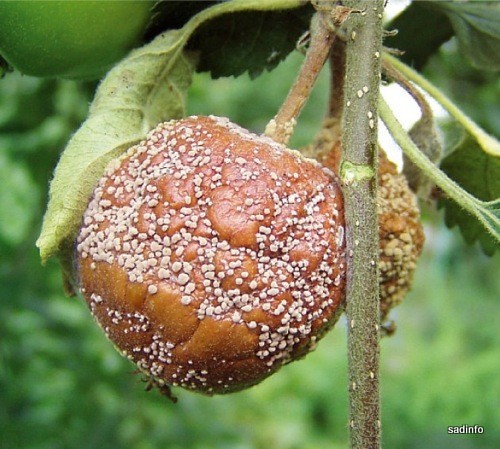 Diseases and pests of apple trees
Diseases and pests of apple trees
The most dangerous diseases of apple trees are: Apple scab and apple mildew.
Apple scab is a fungal disease, which attacks both leaves and fruit, and to a lesser extent, young shoots. The symptoms of the disease are spots appearing first on the leaves, later on fruit. The first spots are olive green, later olive-brown, and dark brown after some time. A tree heavily affected by scab loses its leaves in mid-summer, and the diseased fruit does not reach its normal size and becomes deformed. The source of infection is fallen leaves, on which the fungus hibernates. The time of the most important sprayings therefore falls on the so-called. green flower bud, pink flower bud and late flowering. Applies to spraying: Dodinox (0,15%) the Kaptan zaw. 50 (0,3%) and from the end of April to the June fruit bud drop, additionally – Rubigan (0,03%).
Apple mildew is also a fungal disease, which primarily attacks young apple shoots. Its symptom is mealy, white coating on the tips of the shoots, that do not develop normally. Infected leaves appear to have been sprinkled with flour. Fighting apple powdery mildew involves carefully cutting all of them – from the moment the first leaves appear until flowering – symptomatic shoots, smoking and spraying with Bayleton 5 WP (0,075%).
In addition, they can occur on apple trees: gangrene of the bark, brown rot of pome trees and crayfish of fruit trees.
Brown rot of trees is a fungal disease, which primarily attacks apple and pear fruit. Infected fruit turns brown, and on their surface there are characteristic gray warts. These fruits often dry up on the tree, creating the so-called. mummy, which become the seedbed of the disease in the following year. The fruit is infected, and mummies must also be collected, bury or burn. This disease is combated during the growing season by spraying with preparations against scab on apple trees.
Gangrene of the bark and crayfish of fruit trees cause the dieback of the crown on young branches, and especially on trunks. Bark gangrene affects mainly young trees. If the bark, due to the action of these diseases, dies over most of the trunk circumference or around the trunk, this tree is dying. The wounds caused by cancer of fruit trees are most often formed in the forks of limbs and branches. Combating these diseases consists in cutting out the diseased tissue and smearing the wound with emulsion paint with an additive 1% Topsinu M (on 1 We add kg of paint 0,1 kg prepared).
One of the most dangerous pests of apple trees is the apple fruit (characteristic. 102). The butterfly lays eggs on young fruit buds. After a dozen or so days, caterpillars hatch from the eggs, that bite into the fruit. After feeding, they leave the fruit and hibernate under the bark. Pupation occurs in spring. The most appropriate moment to combat apple fruit is the beginning of the caterpillars hatching from the eggs – in the so-called. black head. The tree is sprayed with Insadofos by Col.. (0,15%), Basudinem 25 EC (0,1%) or Deci-sem 2,5 EC (0,05%).
Another pest is the apple flower. It is a beetle that hibernates on trunks, in cracks in the bark and other such hiding places. During the development of flower buds, the female lays one egg to them. A larva hatches from this egg, which bites the stamens and pistil. A damaged bud is easy to recognize, because it doesn't develop, and the petals turn brown. After maturing, the larva pupates into a dry bud, and after a few days a beetle comes out. It is fought before or during bud break, using the spraying with Owadofos Col.. 50 (0,15%) or Decisem 2,5 EC (0,05%). Kwieciak can also be destroyed, putting on pre-spring bands made of corrugated paper. The bands put on the trunk should be checked in the early morning, because later the beetles spread over the tree (for the night they hide again in armbands).
Very dangerous pests of apple trees include spider mites - tiny arachnids, barely visible to the naked eye. They are called red spiders by gardeners. They suck the juices out of the plants, thus inflicting great losses. Spider mites hibernate on shoots (in the form of red eggs). We fight them, when their abundance is on average above five per leaf, during the period of a pink or white bud – spraying Roztoczola, Pł. 8 – 0,2% the Torque -0,05% and then from the end of flowering to the June bud drop with the same preparations in the same concentration.